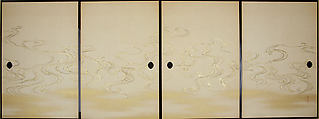Bamboo Grass and Waves
Kamisaka Sekka Japanese
Not on view
Images of water with waves and bamboo grass (sasa) are painted on opposite sides of these sliding-door panels. Here and there a pooled pigment effect (tarashikomi), a signature device of Rinpa-school artists, can be discerned. Kamisaka Sekka was trained in traditional Japanese painting styles, but government-sponsored trips to Paris and Glasgow introduced him to the art of the West, particularly Art Nouveau. Upon returning to Japan, he blended Rinpa-school techniques with elements of Western taste.
During the summer Tanabata Festival, people write wishes on paper strips and fasten them to sasa leaves, often setting them afloat on a river. The Tanabata story, derived from ancient Chinese legend, describes two celestial lovers separated by the heavenly river (Milky Way) and allowed to meet only once a year. The waves and sasa on Sekka’s screens may be a reference to this festival and tale.
Due to rights restrictions, this image cannot be enlarged, viewed at full screen, or downloaded.
This artwork is meant to be viewed from right to left. Scroll left to view more.











